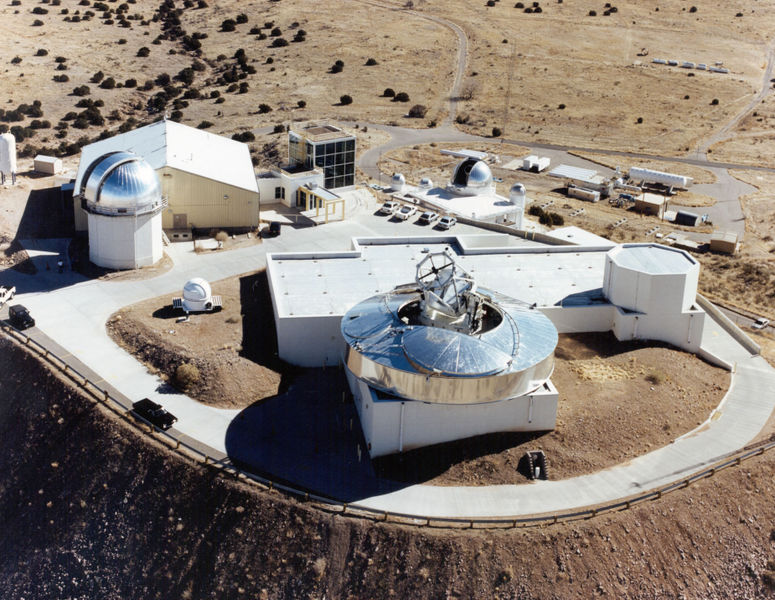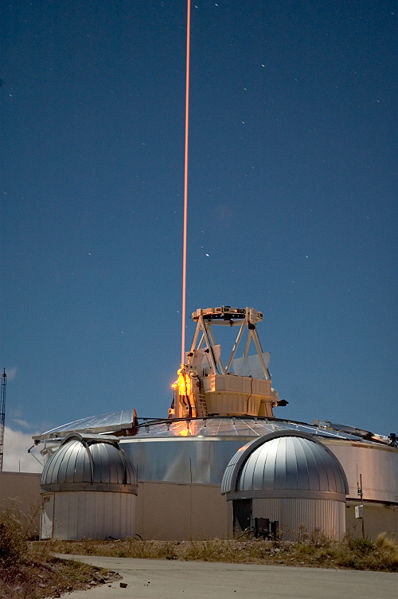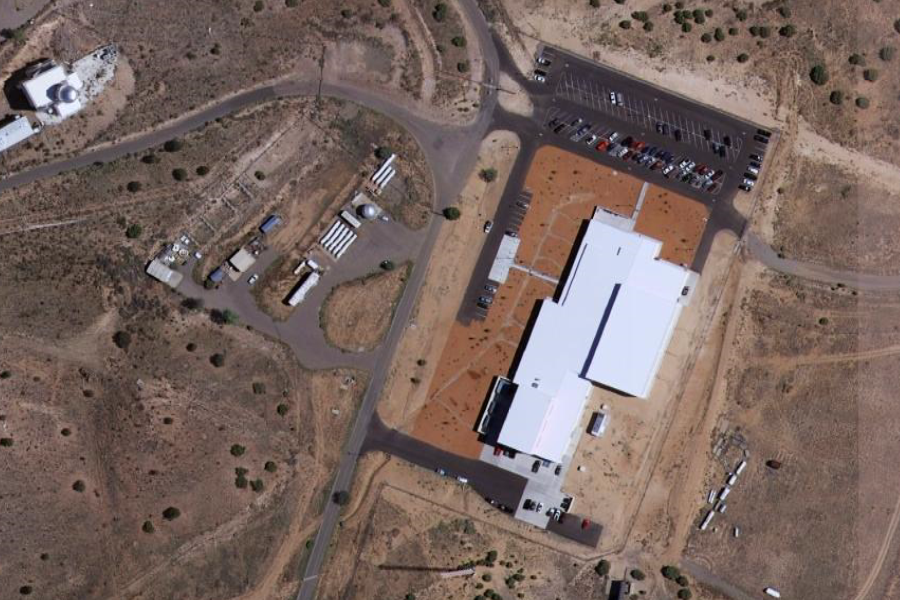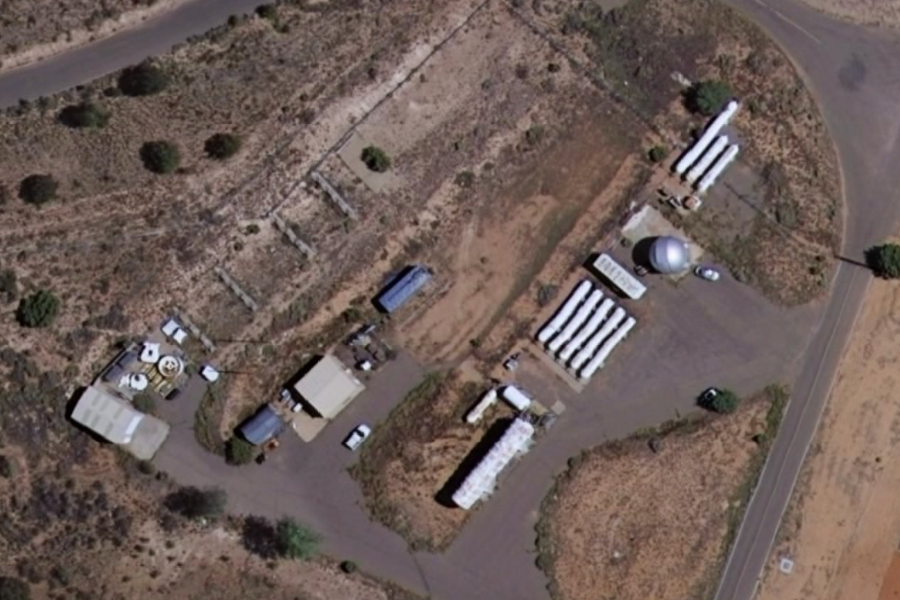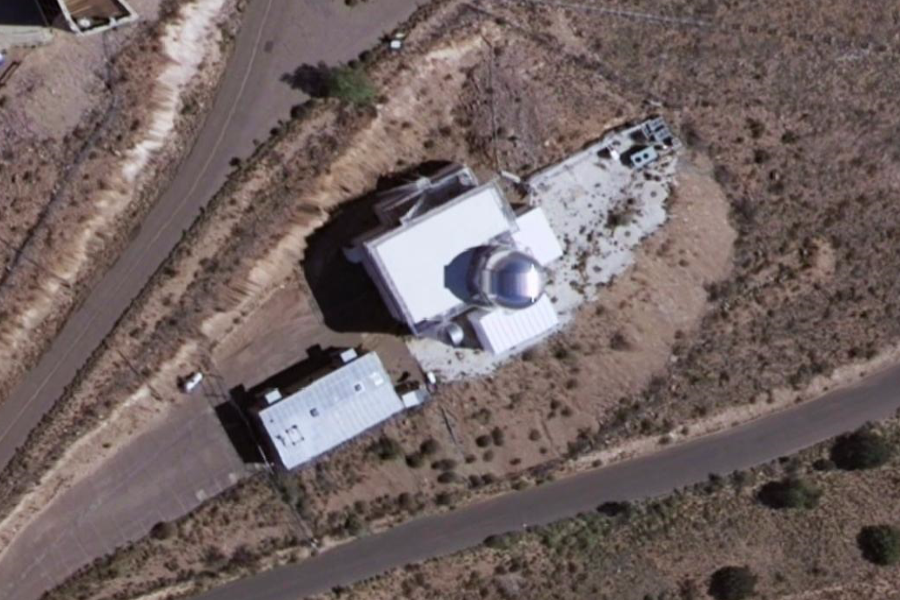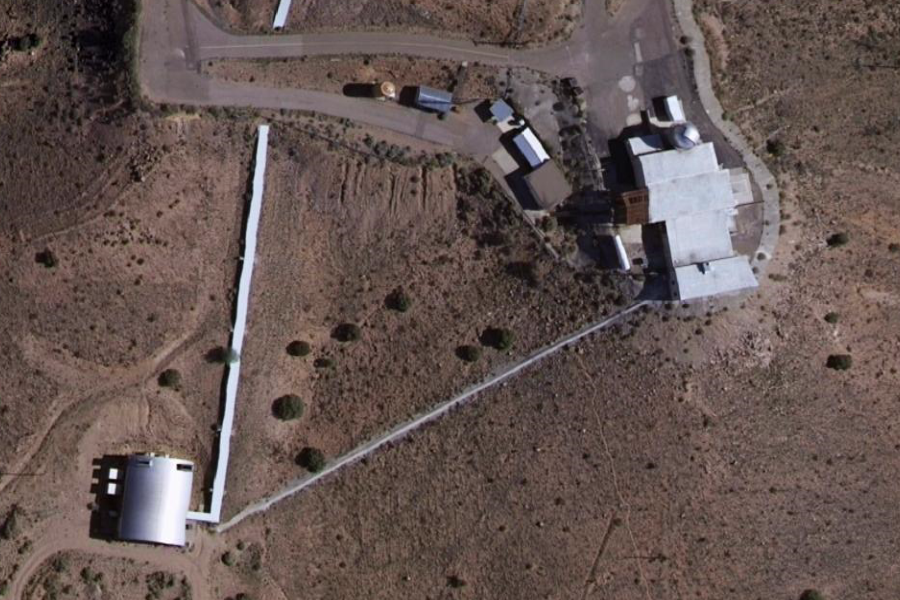Kirtland AFB
Starfire Optical Range
Directed Energy Directorate
Air Force Research Laboratory
Kirtland Air Force Base, N. M |
Directed Energy Directorate
..The Air Force Research Laboratory’s Directed Energy Directorate develops high-energy lasers, high-power microwaves, and other directed energy technologies for the United States Air Force and the Department of Defense . The Directorate is also involved with advanced optics and imaging technologies to improve the nation’s ability to precisely project these directed energies at the speed of light anywhere, at any time and with graduated intensity. AFRL Directed Energy Directorate: http://www.kirtland.af.mil/afrl_de/ Editors Note: Notice the right side of the logo above from the original site link...
http://www.de.afrl.af.mil/ |
| Space Shuttle Columbia: This image is a view of the underside of the space shuttle Columbia during its entry from mission STS-107 on Feb. 1, 2003, as it passed by the Starfire Optical Range, Directed Energy Directorate, Air Force Research Laboratory, Kirtland Air Force Base, N. M. The space shuttle Columbia image was taken at approximately 7:57 a.m. CST (1357 GMT). This image was received by NASA as part of the space shuttle Columbia accident investigation and is being analyzed. Image © NASA; Used By Permission |
| Leuren Moret and Alfred Webre call for International Citizen's 9/11 War Crimes Tribunal II. Overwhelming evidence exists that the collapses of the Twin Towers and Building 7 were instances of controlled demolition, and/or of the application of exotic weapons such as land-based, air-based or possible space-based Directed Energy Weapons (DEW). But al-Qaeda operatives could not have obtained the needed access to the buildings to plant the explosives and would not have ensured that the buildings come straight down. Nor could al-Qaeda operatives have obtained command and control of advanced Directed Energy Weapons, Microfusion devices (4th generation mini-nuclear weapons), bunker-busters, or other exotic weapons alternatives that are known to be in the deployment or testing phase in the US Defense arsenal. The controlled demolition and/or Directed Energy Weapons (DEW) or exotic weapons application, therefore, had to be the work of U.S. Government and other insiders. That President Bush was one of those insiders is suggested by the fact that his brother and cousin were principals in the company in charge of WTC security. Complicity at the highest levels of the federal government is also indicated by the removal of evidence (the collapsed steel), which at a crime scene is normally a federal offense. Finally, if the airplane strikes could have occurred only with the consent of the President and the Secretary of Defense (as suggested in the previous point), the coordination of these strikes with the demolition of the buildings - and/or with the use of exotic weapons such as Directed Energy Weapons - implies their involvement in the latter as well. The design of the International Citizen's 9/11 War Crimes Tribunal is to provide a judicial, impartial forum for the evaluation of forensic evidence. At present, there are several alternative, though not mutually exclusive models of how the WTC Towers fell, in a controlled demolition. While there is compelling evidence for one model over another at this time, the purpose of an impartial forum is to allow evidence to be presented. This includes evidence of traditional chemical means of controlled demolition, as well as more exotic means, as warranted by the forensic evidence. The models of controlled demolition to be explored, thus would include at least: traditional thermite and thermate exposives; Microfusion devices (4th generation nuclear weapons); and Directed Energy Weapons (DEW), be they land-based, air-based, or space-based. Correspondence with the USAF Kirtland Base Directed Energy Directorate does not rule out the existence of Directed Energy Weapons in these configurations. SOURCE: Atlantic Free Press |
Starfire Optical RangeStarfire Optical Range is a United States Air Force research laboratory on the Kirtland Air Force Base in Albuquerque, New Mexico. Their primary duty, according to their official website, is to "develop and demonstrate optical wavefront control technologies". The range is a secure lab facility (SLAB) and they are a division of the Directed Energy Directorate of the Air Force Research Laboratory. Among their optical equipment, they have a 3.5 meter telescope (which they claim is "one of the largest telescopes in the world equipped with adaptive optics designed for satellite tracking"), a 1.5 meter telescope, and a 1.0 meter beam director. According to an article published on May 3, 2006 in the New York Times, research is being conducted at the laboratory into how to use ground-based lasers to disable satellites; that is, as an anti-satellite weapon. According to the article, research is being conducted so that the ground-based laser would be able to use adaptive optics to remove the effects of atmospheric turbulence. |
Courtesy of US Air Force (click for full size)Starfire Optical Range at Kirtland Air Force Base in Albuquerque, New Mexico. "View of the SOR taken from a helicopter. 3.5m enclosure open to show telescope. ABD and 1.5m dome also shown." Research is taking place there into how to use ground-based lasers to disable satellites." http://www.de.afrl.af.mil/SOR/SORfacilities.htm
.. Courtesy of US Air Force (click for full size)Starfire Optical Range Site showing 3.5m telescope, 1.5m telescope, Auxiliary Beam Director (ABD), and associated facilities. (Note: Center right of the image is a view of the long tube and camouflaged tent that Jack spooted in Google Earth (see below)) |
Starfire Optical Range Mission The primary mission of the SOR is to develop and demonstrate optical wavefront control technologies. The Starfire Optical Range houses a 3.5 meter telescope (one of the largest telescopes in the world equipped with adaptive optics designed for satellite tracking), a 1.5 meter telescope, and a 1.0 meter beam director. In addition to its primary research charter, the SOR also supports field experiments by others within the research community. http://www.de.afrl.af.mil/SOR/
.. Visiting the site gives you the above notice and despite the stated "primary mission" the facilities page gives the real purpose below... |
Auxiliary Beam Director
..Courtesy of US Air ForceThe beam director is used primarily for projecting laser beams at space objects and is occasionally used for making wide field images of astronomical objects. The coelostat is capable of pointing over a complete hemisphere while allowing lasers and sensors to remain stationary in the attached laboratory. - SOURCE |
FASOR Sodium Laser
..Courtesy of Directed Energy Directorate, US Air Force
(click image for full size)A FASOR used at the Starfire Optical Range for LIDAR and laser guide star experiments is tuned to the sodium D2a line and used to excite sodium atoms in the upper atmosphere. Original caption: "This sodium laser—being fired from the Starfire Optical Range on Kirtland Air Force Base, New Mexico—is used with deformable optics to help eliminate atmospheric distortions when gathering images of objects in space." Though the caption states that this is a "sodium laser", this is actually misleading as the Starfire Optical Range LIDAR laser seen here is actually two solid state IR lasers, 1.064 and 1.319 microns, that are frequency summed in LBO within a doubly resonant cavity. The orange beam is observed due to the intense laser light scattering off particles in the air. In general, laser light travelling through a vaccum can not be seen unless aimed directly towards the observer. |
Green Laser
..Courtesy of Directed Energy Directorate, US Air Force
(click image for full size)Original caption: "Three green lasers are seen emanating from facilities at the Starfire Optical Range on Kirtland Air Force Base, New Mexico. Lasers and deformable optics are used here to eliminate or minimize optical distortions caused by the Earth’s atmosphere." Administration Researches Laser Weapon The Bush administration is seeking to develop a powerful ground-based laser weapon that would use beams of concentrated light to destroy enemy satellites in orbit. The largely secret project, parts of which have been made public through Air Force budget documents submitted to Congress in February, is part of a wide-ranging effort to develop space weapons, both defensive and offensive. No treaty or law forbids such work. The laser research was described by federal officials who would speak only on the condition of anonymity because of the topic's political sensitivity. The White House has recently sought to play down the issue of space arms, fearing it could become an election-year liability. SOURCE: Washington Post 05/03/2006 Starfire The Air Force Phillips Laboratory at its Starfire optical Range (SOR) has installed the world's largest telescope capable of tracking low earth-orbiting satellites. The telescope has a 3.5-meter (1 l.5 feet) diameter primary mirror and is protected by a unique retracting cylindrical enclosure that allows the telescope to operate in the open air. once equipped with adaptive optics, the telescope will be capable of resolving basketball-sized objects 1,OOO miles in space. SOURCE: Global Security.org See Also Pegasus Pages
Weapons in Space - The State of the Art |
Starfire Optical Range 3.5m telescope
Courtesy of Directed Energy Directorate, US Air ForceThe 3.5 meter telescope facility is expected to become one of the world's most capable for obtaining ultra-high resolution images at visible wavelengths. Near diffraction limited performance (in the 0.6-1.0 micron wavelength region and to an apparent visual magnitude limit greater than tenth) will be achieved within the next few years through the use of high-order adaptive optics and a sodium wavelength laser beacon. First light with the adaptive optics installed was achieved in September of 1997. View the binary star image taken on the 3.5m telescope with adaptive optics. Much attention has also been directed at minimizing thermally-induced turbulence throughout the 3.5 meter telescope facility. The outstanding example of this effort is a fully collapsible telescope enclosure. The facility is cooled by a closed-cycle water system chilled by ice stored underground, away from the facility. The 3.5 meter telescope is a classical Cassegrainian optical design with a coudé path. Sensors and other auxiliary instrumentation can be mounted at one of two Naysmyth optical breadboards on the telescope itself or in one of several coudé laboratories. SOURCE: http://www.de.afrl.af.mil/SOR/3_5m_telescope.htm |
Google Maps 2006
+34° 57' 51.48", -106° 27' 45.36"
..Google Maps 2008
+34° 57' 51.48", -106° 27' 45.36"
..The whole area around Kirtland AFB shows many new projects under construction. Above we can see the new additions to the Starfire facility .. |
Starfire 2009
...Google Earth 2009
..Google Earth 2009
..Google Earth 2009
..Google Earth 2009
..Google Earth 2009
..Google Earth 2009
..Google Earth 2009
..Google Earth 2009
..Google Earth 2009 |
| FAIR USE NOTICE: This page contains copyrighted material the use of which has not been specifically authorized by the copyright owner. Pegasus Research Consortium distributes this material without profit to those who have expressed a prior interest in receiving the included information for research and educational purposes. We believe this constitutes a fair use of any such copyrighted material as provided for in 17 U.S.C § 107. If you wish to use copyrighted material from this site for purposes of your own that go beyond fair use, you must obtain permission from the copyright owner. |
| ~ MENU ~ |





